Helium Shortages in the Chemistry Lab: Compound Characterization Using Helium-Free Techniques
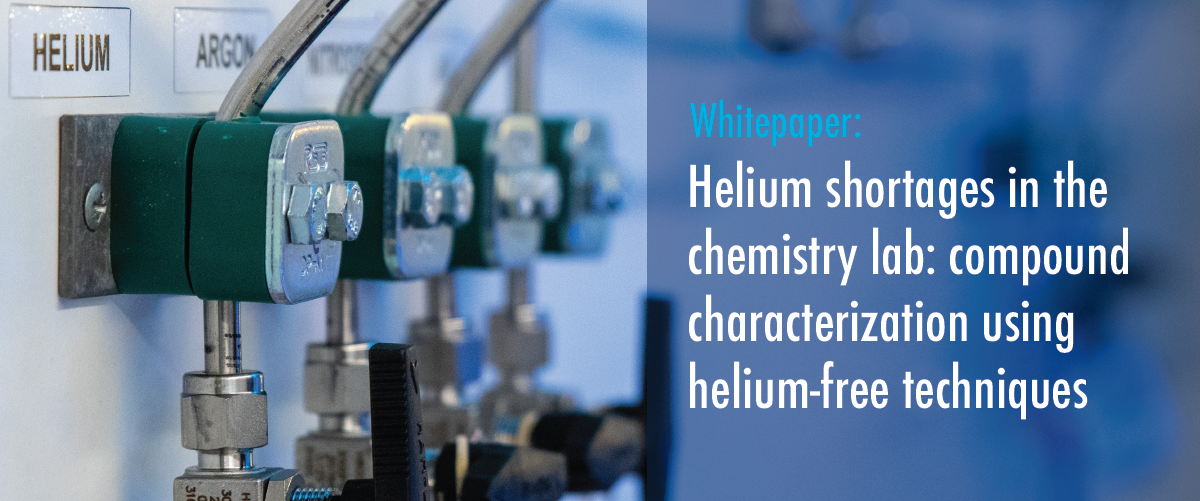
Helium shortages are not new – annually, scientists see the cost of helium rise and fall like the stock market. Except this isn’t just a financial impact. Global helium shortages threaten to derail research and essential industry functions, taking down GC and high-field NMR instruments, bringing a once state-of-the-art lab down to a bare-bones facility.
This whitepaper explores the use of alternative reaction monitoring technology, including the expression® CMS (Compact Mass Spectrometer), Plate ExpressTM TLC Plate Reader, and ASAP® probe for liquid and solid samples – all helium-free alternatives for the chemistry laboratory.
Reaction Monitoring Capabilities at the Bench:
The expression® CMS offers an ideal reaction monitoring solution that will live on long beyond the helium shortage and become a centerpiece of the lab. The system offers a complete solution for:
- Batch and flow chemistry
- Fast compound identification and purity determination
- …with little or no sample preparation required, and many novel sample introduction interfaces
High-Throughput Purification of Five Over-the-Counter & Prescription Drug Compounds by Reverse-Phase Preparative LC-MS

Instrumentation:
puriFlash® 5.250
expression® CMS
Uptisphere® StrategyTM column US5C18HQ-150/300
Authors:
Advion Interchim Scientific, Montluçon, France Headquarters
Introduction
Purification is a critical step in drug development. From research, to scale-up to process, purification and confirmation are essential steps in bringing a drug to market. It is essential to have a high-throughput solution that offers sufficient quantity and reproducible quality of purified compounds. The separation of the active pharmaceutical ingredients (APIs) from their impurities can be easily achieved with a preparative chromatography system.
This application note features the purification of five active ingredients found in over-the-counter (OTC) drugs including caffeine, glafenine, ketoprofen, flavone, and fenofibrate (Figure 1), by a preparative purification workflow with confirmation using a compact mass spectrometer.
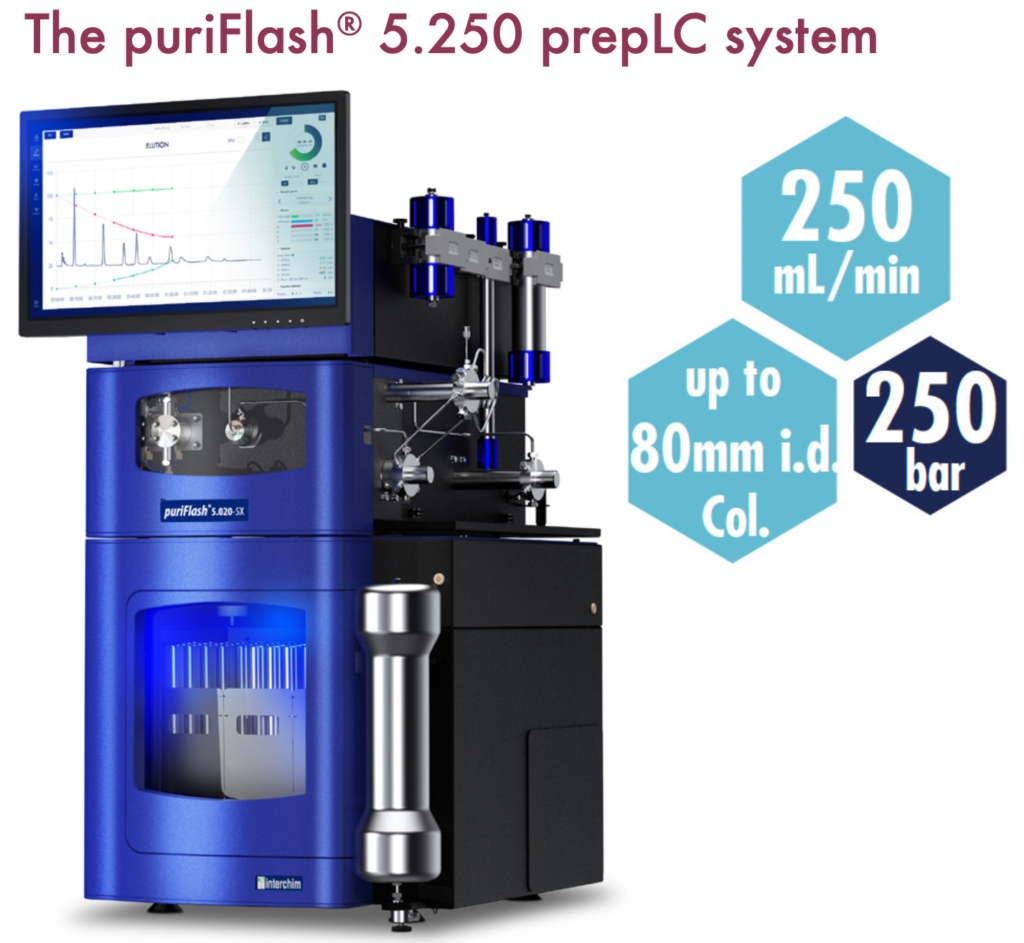
Figure 1: The five compounds of interest include caffeine, glafenine, ketoprofen, flavone, and fenofibrate. Chemical structures and pharmaceutical use cases are highlighted below.

Caffeine: A natural chemical with stimulant effects, caffeine can be found purified in tablet form, or naturally occurring in coffee, tea, cocoa and more.
Glafenine: A nonsteroidal anti-inflammatory drug (NSAID), glafenine was removed from the market in 1991 due to a high risk of anaphylaxis.
Ketoprofen: A prescription-based nonsteroidal anti- inflammatory drug (NSAID), ketoprofen is used to treat inflammation, swelling, stiffness and joint pain. The drug was discontinued in 1995 due to increased risk of heart attack, stroke, irritation and other issues.
Flavone: A metabolite and nematicide that commonly exists in plants.
Fenofibrate: A prescription medication used to reduce and treat high cholesterol and triglyceride (fat-like substances) levels in the blood.
Experiment
Exploratory LC Separation
Figure 2: To confirm the presence of the pre-identified compounds, an exploratory LC-UV run confirmed the presence of the drug compounds prior to purification.

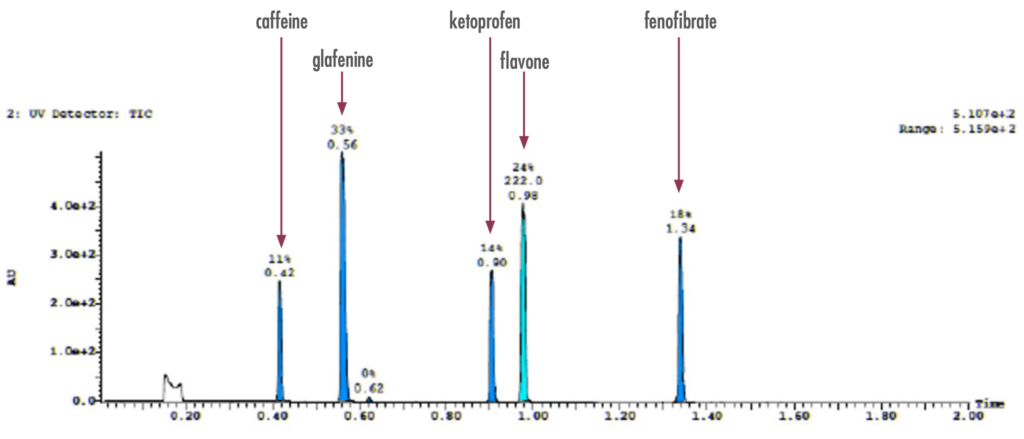
Preparative LC Run
Following the positive ID of the five compounds of interest and their elution points, the drug mixture was then ready for a preparative LC-UV run on the puriFlash® 5.250 iELSD. The purification is aided by the iELSD pack, enabling the detection of chromophore-free compounds (Figure 3).




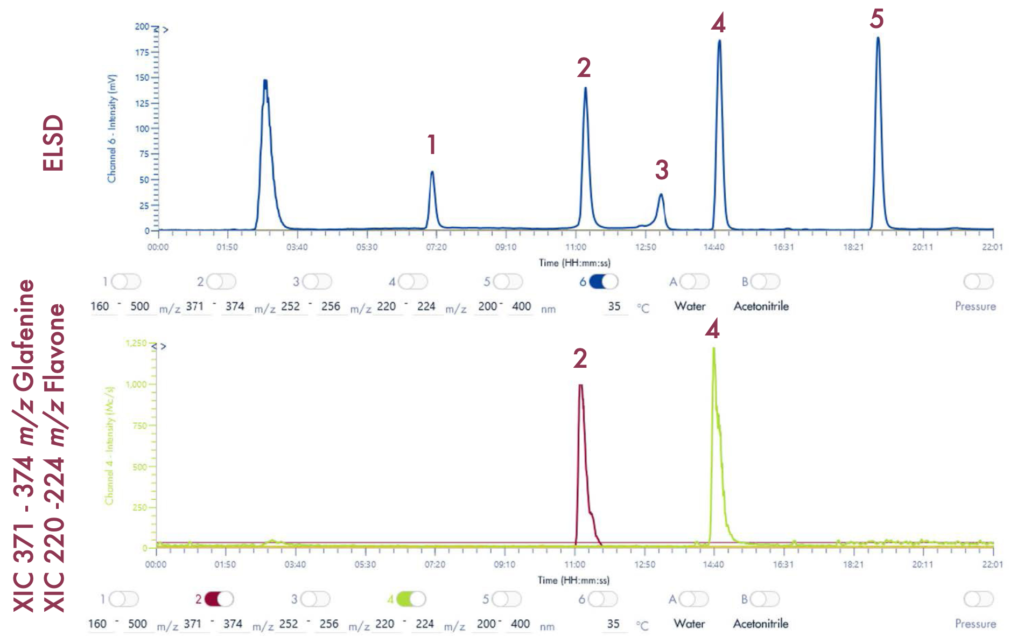
Results and Validation
Separation & Purification Results
The identity of the separated compounds was confirmed using the Advion Interchim Scientific expression® Compact Mass Spectrometer, quickly and accurately identifying the compounds of interest.
The purity of these compounds can be verified using analytical scale HPLC.
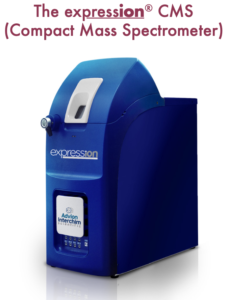
SOLATION®, A New ICP-MS for the Detection of Heavy Metals in Cannabis and Hemp
Introduction
Cannabis and hemp products are becoming much more available for medicinal and recreational use making routine testing for toxic heavy metals much more important. Advion Interchim Scientific introduces the SOLATION® ICP-MS for the analysis of heavy metals in cannabis plant and cannabis product samples. While there are no federal guidelines for heavy metals in cannabis, states where cannabis use and production are legal have adopted exposure limits and QC criteria for Arsenic, Cadmium, Mercury, and Lead based on USP<233>. Here, we report the results of our sample analysis using these guidelines.
Methods
Cannabis flower was purchased locally and finely ground for analysis. Samples are prepared using a microwave digestion system (CEM Mars 6, Matthews, NC). Method validation for USP<233> is based on accuracy, using spike recoveries, repeatability based on the %RSD of six independently digested replicate, and ruggedness, where those 6 replicates are run a second time by another analyst, another instrument, or on another day. The spike levels are based on the “action level” defined by the California maximum permitted daily exposure (PDE) limits as a guide: Lead 0.5 µg/g, Arsenic and Cadmium 0.2 µg/g, and Mercury 0.1 µg/g are used to define the 100% spike level. Samples are also spiked at 50% and 150% of the action level.
Preliminary Data
For digestion, 0.5 g (+/- 0.002g) of sample is treated with 9mL conc. HNO3 and 1mL conc. HCl in a microwave vessel and allowed to react for 15 minutes prior to being capped. The vessels are loaded onto the carousel in the microwave and the “one touch” cannabis method, supplied by CEM, is used. Samples are brought to 200°C in 30 minutes, held there for 10 minutes, and allowed to cool. The result is a clear, particle free solution. The SOLATION® ICP-MS was used to analyze the samples for As, Cd, Hg, and Pb after digestion and dilution. The results show that the SOLATION® ICP-MS was able to produce accurate values as measured by the spike recoveries which were well within the 70-150% range. The results from the 6 independent digests were within the defined limit of 20% RSD. Repeat analysis of the 6 digests on a separate day showed good agreement with the initial results and were within the 25% RSD spec. defined by USP<233>. Overall results show that the SOLATION® ICP-MS is an effective instrument for the analysis of cannabis and hemp samples.
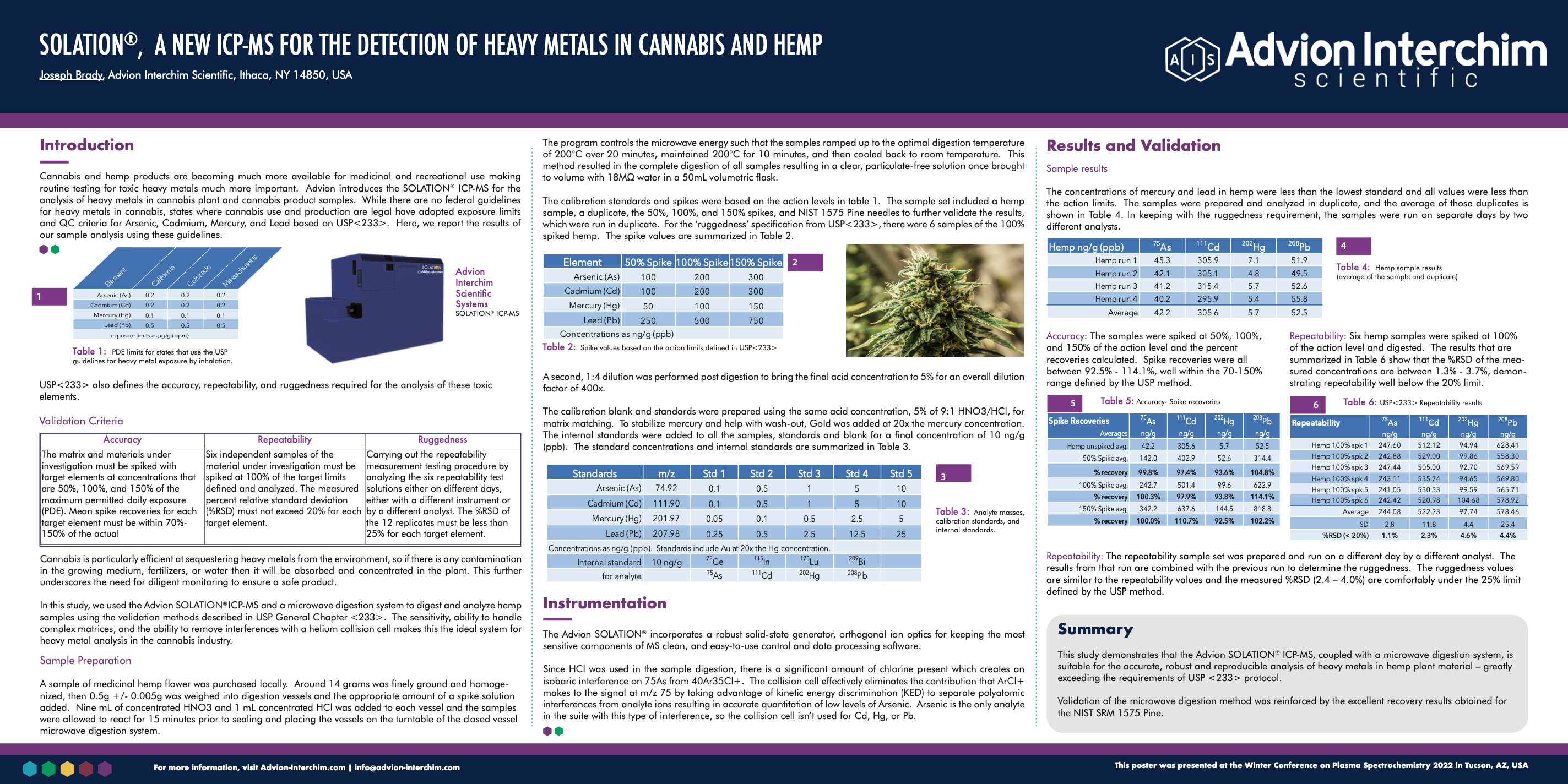
Mass Directed Fraction Collection of Natural Products: Examples from Turmeric & Green Tea Extract
Introduction
Natural products have been a source of inspiration for pre-clinical drug discovery both by exploring traditional medicines and to discover new spaces in pharmacology. Isolation and characterization of natural products remains a major barrier in drug discovery. Isolation is generally done on an analytical scale and then compounds are characterized fully before any scaleup purifications are attempted. The ability to purify compounds in complex natural product mixtures by highly specific MS data allows for the simplification of the purification and characterization steps of the process. Here, flash and prep chromatography are coupled with MS detection to purify natural products in green tea and turmeric extracts.
Methods
Isolation of the major catechins in green tea and the major curcuminoids in turmeric was completed via extractions. Green tea leaves were extracted, and the crude material was analyzed using UPLC-MS and analytical standards to identify the catechins of interest and develop a suitable prep-LC method for isolation. Turmeric powder was extracted and then analyzed by TLC-MS using Advion’s Plate Express™ to identify the compounds of interest and develop a suitable flash chromatography method for isolation. Both extracts were purified using mass-directed fraction collection using Interchim’s puriFlash 5.250 flash/prep chromatography system connected to Advion’s expression® single quadrupole mass spectrometer. Target compounds were detected using XIC MS channels. Purity of the isolated compounds was then determined using HPLC-MS.
Preliminary Data
We were able to successfully isolate the 3 major curcuminoids (curcumin, demethoxycurcumin, and bisdemethoxycurcumin) in turmeric and the 5 major catechins in green tea ((-)-epigallocatechin (EGC), (-)-epicatechin (EC), (-)-epigallocatechin-3-gallate (EGCG), (-)-epicatechin-3-gallate (ECG), and (-)-gallocatechin gallate (GCG) with high purity (≥95%).
An isocratic flash chromatography method (97:3 DCM:MeOH) was developed using TLC (97:3 DCM:MeOH) to purify the curcuminoids. The TLC plate was analyzed by APCI– MS using the Plate Express which extracts spots directly from the plate with no need for sample preparation. Fractions were collected using extracted ion chromatogram (XIC) channels with APCI– MS. Fractions were then characterized by ASAP– MS and purity for each fraction was determined using HPLC-MS.
A preparative LC method was developed for the catechins in green tea using HPLC-MS and reference standards to identify each compound of interest. Using a water methanol gradient and collecting fractions using XIC channels set for the compounds of interest. Fractions were characterized and their purity determined by HPLC-MS. EGC, EGCG, GCG, and ECG fractions were determined to have purities of 100 %, 99.8 %, 98.8, and 100 % respectively.
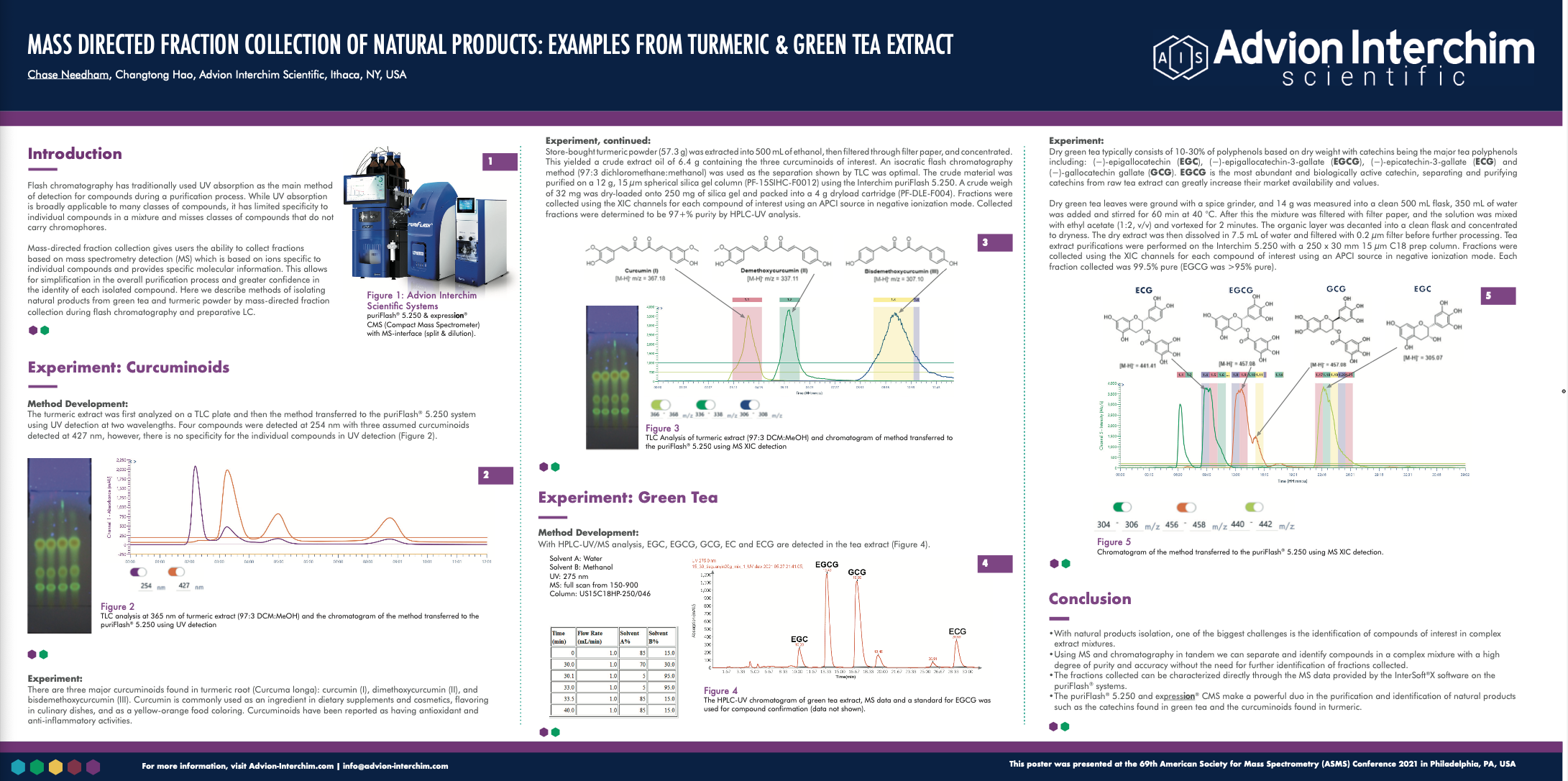
Introducing the Advion Interchim Scientific SOLATION® ICP-MS
Introduction
The SOLATION® Inductively Coupled Plasma Mass Spectrometer (ICP-MS) puts the power of trace, multi-elemental analysis in your hands by simplifying and optimizing the typical ICP-MS workflow, inside and out. The system offers high performance, multi-elemental analysis, ideal for environmental, clinical, biomedical, food, agriculture, and geological applications.
The SOLATION® offers a state-of-the-art quadrupole deflector that ensures the analyzer and detector stay clean and improves S/N by preventing neutrals and particles from entering the analyzer. The system is also designed for lower argon consumption.
Key System Infrastructure Includes:
- Ion extraction cones: Triple-cone ion extraction, followed by an Einzel lens, which are electrically controlled to maximize transmission of ions into the vacuum system.
- RF coil: Plasma generation with water cooled RF coil using industry standard 27 MHz variable frequency generator for rapid impedance matching and ultimate performance with challenging matrices.
- Torch: One-piece, demountable torch with fast, one-step connection of argon and ignitor. Optional shield to prevent secondary discharge.
- Nebulizer: High efficiency concentric nebulizer available in glass or quartz for compatibility with the widest range of flow rates and sample composition.
- Spray chamber: The cyclonic spray chamber with optional temperature control further reduces droplet size and solvent load to ensure stable, efficient plasma.
- Peristaltic pump: Integrated 4-channel, 12-roller pump for maximum flexibility and ultra-low pulsation. Software controlled flow rate from 1 μL/min to >1 mL/min.
- Gate valve: Allows quick and easy maintenance and replacement of the cones whilst maintaining vacuum integrity.
- 90° Quadrupole deflector: Ensures that the analyzer and detector are not in line with the plasma beam, preventing neutrals and particles from entering the analyzer, improving S/N and preventing contamination.
- Octupole collision cell: Acts as an ion guide and a collision cell with He gas to provide Kinetic Energy Discrimination (KED) to remove interferences.
- Quadrupole Analyzer: High frequency mass filter design with the highest stability to simultaneously maximize transmission, resolution, and abundance sensitivity.
- Dual function detectors: Measures in both analog and pulse detection modes with seamless transmission between the two, to allow measurement of high and low levels in a single analysis with more than 9 orders of magnitude of linear dynamic range.
- Pulse Detection: captures ions generating pulses shorter than 20 ns; accurate and linear to minimum dwell time of less than 100 μs
- Analog Detection: used for higher ion signals while pulse detection is deactivated to extend detector lifetime.
- Mass Dependent software control: Software designed to optimize specific mass ranges independently to allow for mass specific tune optimization.
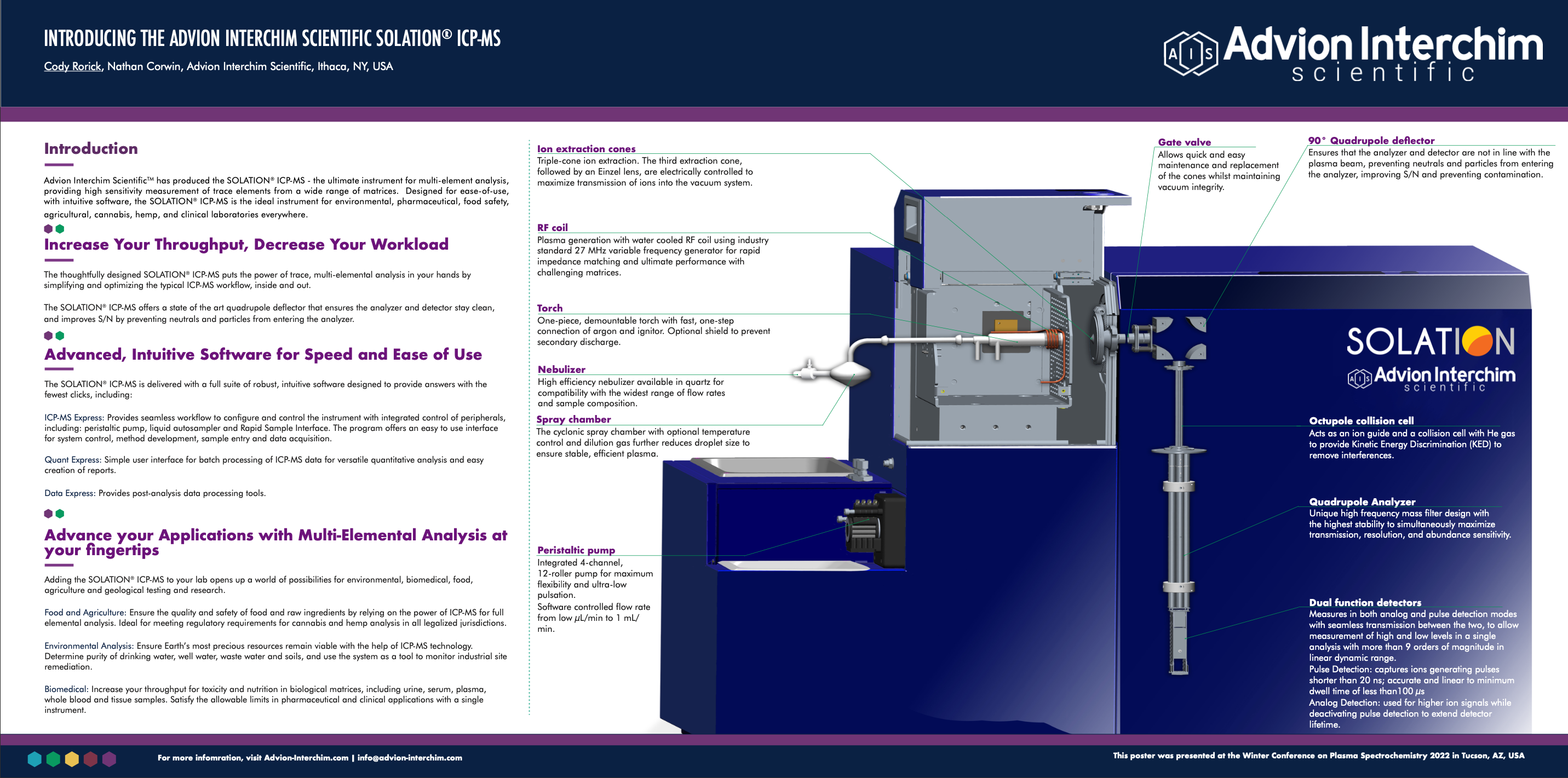
Analysis of Heavy Metals in Cannabis using the SOLATION® ICP-MS
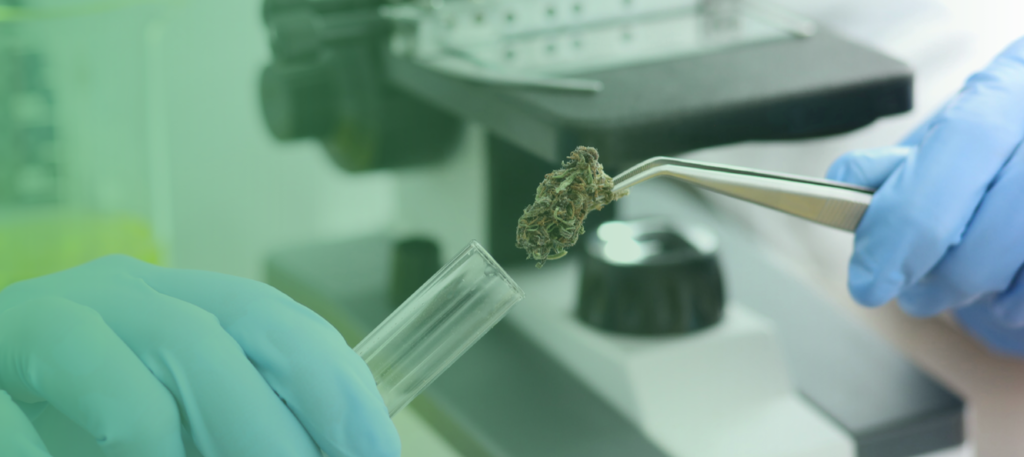
Instrumentation: SOLATION® ICP-MS
INTRODUCTION
With the growing acceptance and legalization of hemp and cannabis in the US, Canada, and several other countries, cannabis products are more widely available than ever before. Now approved for medical, recreational and health supplement uses, increased production and consumption have highlighted the need for routine testing and development of testing standards for toxic chemicals, including heavy metals, in cannabis plant material, and all the byproducts made from them, to ensure safe products for the consumer. With the adoption of chapters <232> and <233>, US Pharmacopeia (USP) specifies a list of elements and maximum exposure limits based on toxicity and routes of administration for pharmaceutical products.
Many states that have legalized medical and recreational cannabis base their exposure limits on the USP values. California, Colorado, and Massachusetts are examples with Permissible Daily Exposure (PDE) limits by inhalation for As, Cd, Hg, and Pb. These values are summarized in Table 1.
Table 1: PDE limits for states that use the USP guidelines for heavy metal exposure by inhalation. USP<233> also defines the accuracy, repeatability, and ruggedness required for the analysis of these toxic elements:
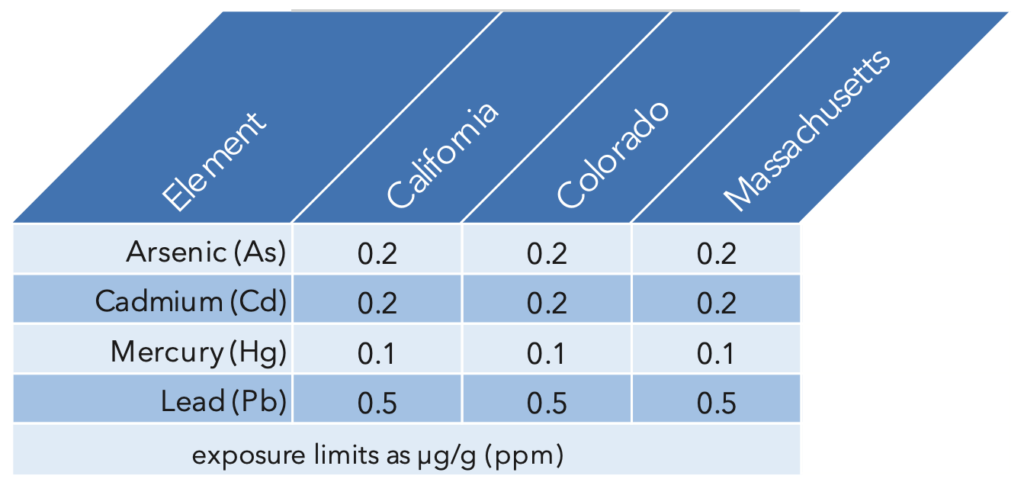
Validation Criteria
Accuracy: The matrix and materials under investigation must be spiked with target elements at concentrations that are 50%, 100%, and 150% of the maximum permitted daily exposure (PDE). Mean spike recoveries for each target element must be within 70%-150% of the actual.
Repeatability: Six independent samples of the material under investigation must be spiked at 100% of the target limits defined and analyzed. The measured percent relative standard deviation (%RSD) must not exceed 20% for each target element.
Ruggedness: Carrying out the repeatability measurement testing procedure by analyzing the six repeatability test solutions either on different days, either with a different instrument or by a different analyst. The %RSD of the 12 replicates must be less than 25% for each target element.
In this study, we used the Advion SOLATION® ICP-MS and a microwave digestion system to digest and analyze hemp samples using the validation methods described in USP General Chapter <233>. The sensitivity, ability to handle complex matrices, and the ability to remove interferences with a helium collision cell makes this the ideal system for heavy metal analysis in the cannabis industry.
EXPERIMENT
Sample Preparation
A sample of medicinal hemp flower was purchased locally. Around 14 grams was finely ground and homogenized, then 0.5g +/- 0.005g was weighed into digestion vessels and the appropriate amount of a spike solution added. Nine mL of concentrated HNO3 and 1 mL concentrated HCl was added to each vessel and the samples were allowed to react for 15 minutes prior to sealing and placing the vessels on the turntable of the closed vessel microwave digestion system. The program controls the microwave energy such that the samples ramped up to the optimal digestion temperature of 200°C over 20 minutes, maintained 200°C for 10 minutes, and then cooled back to room temperature.
This method resulted in the complete digestion of all samples resulting in a clear, particulate-free solution once brought to volume with 18MΩ water in a 50mL volumetric flask.
The calibration standards and spikes were based on the action levels in table 1. The sample set included a hemp sample, a duplicate, the 50%, 100%, and 150% spikes, and NIST 1575 Pine needles to further validate the results, which were run in duplicate. For the ‘ruggedness’ specification from USP<233>, there were 6 samples of the 100% spiked hemp. The spike values are summarized in Table 2.
Table 2: Spike values based on the action limits defined in USP<233>
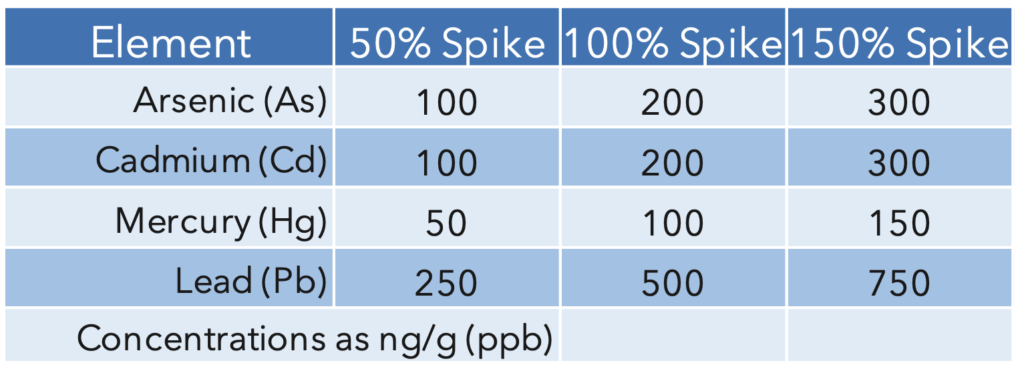
A second, 1:4 dilution was performed post digestion to bring the final acid concentration to 5% for an overall dilution factor of 400x. The calibration blank and standards were prepared using the same acid concentration, 5% of 9:1 HNO3/HCl, for matrix matching. To stabilize mercury and help with wash-out, Gold was added at 20x the mercury concentration. The internal standards were added to all the samples, standards and blank for a final concentration of 10 ng/g (ppb). The standard concentrations and internal standards are summarized in Table 3.
Table 3: Analyte masses, calibration standards, and internal standards.

Instrumentation
The Advion SOLATION® ICP-MS incorporates a robust solid-state generator, orthogonal ion optics for keeping the most sensitive components of MS clean, and easy-to-use control and data processing software.
Since HCl was used in the sample digestion, there is a significant amount of chlorine present which creates an isobaric interference on 75As from 40Ar35Cl+. The collision cell effectively eliminates the contribution that ArCl+ makes to the signal at m/z 75 by taking advantage of kinetic energy discrimination (KED) to separate polyatomic interferences from analyte ions resulting in accurate quantitation of low levels of Arsenic. Arsenic is the only analyte in the suite with this type of interference, so the collision cell isn’t used for Cd, Hg, or Pb.
A glass concentric nebulizer fitted to a cyclonic spray chamber, connected to the standard torch with an injector ID of 2mm, was used for sample introduction. Instrument running parameters are summarized in Table 4.
Table 4: ICP-MS Parameters
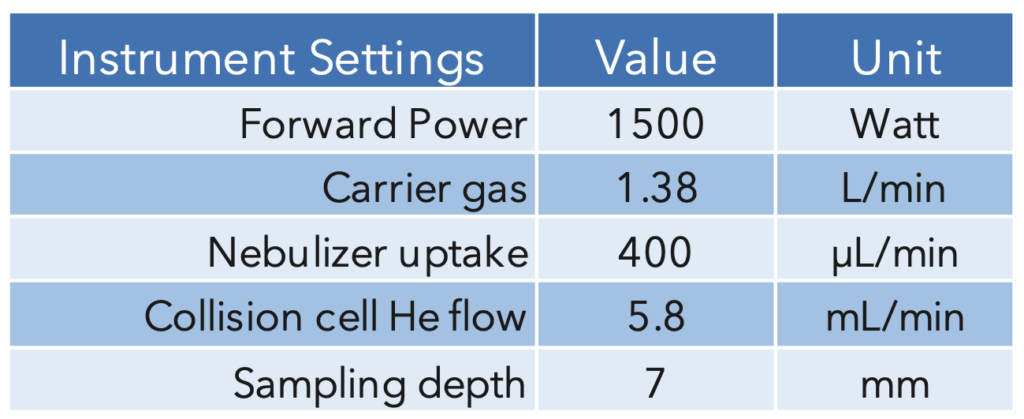
RESULTS AND VALIDATION
Sample Results
The concentrations of mercury and lead in hemp were less than the lowest standard and all values were less than the action limits. The samples were prepared and analyzed in duplicate, and the average of those duplicates is shown in Table 5. In keeping with the ruggedness requirement, the samples were run on separate days by two different analysts.
Table 5: Hemp sample results (average of the sample and duplicate)

Accuracy: The samples were spiked at 50%, 100%, and
150% of the action level (Table 2 above) and the percent recoveries calculated. Spike recoveries were all between 92.5% – 114.1%, well within the 70-150% range defined by the USP method.
Table 6: Accuracy- Spike recoveries
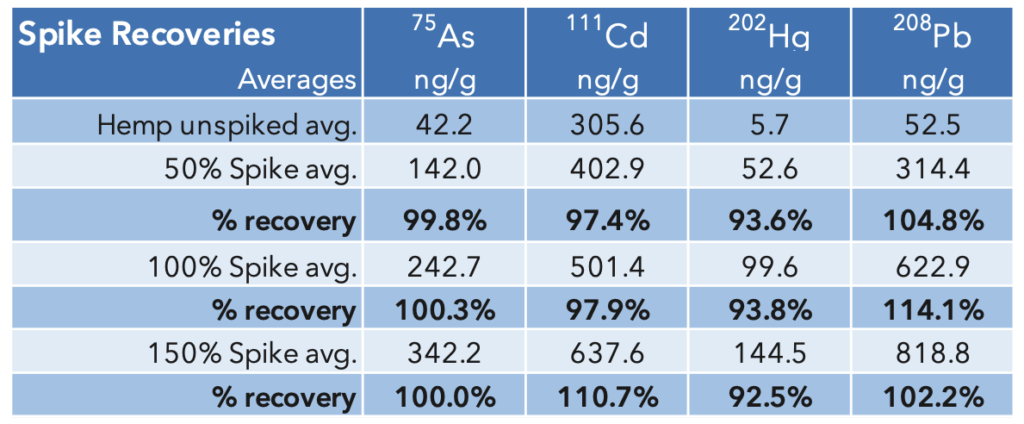
Repeatability: Six hemp samples were spiked at 100% of the action level and digested. The results that are summarized in Table 7 show that the %RSD of the measured concentrations are between 1.3% – 3.7%, demonstrating repeatability well below the 20% limit.
Table 7: USP<233> Repeatability results
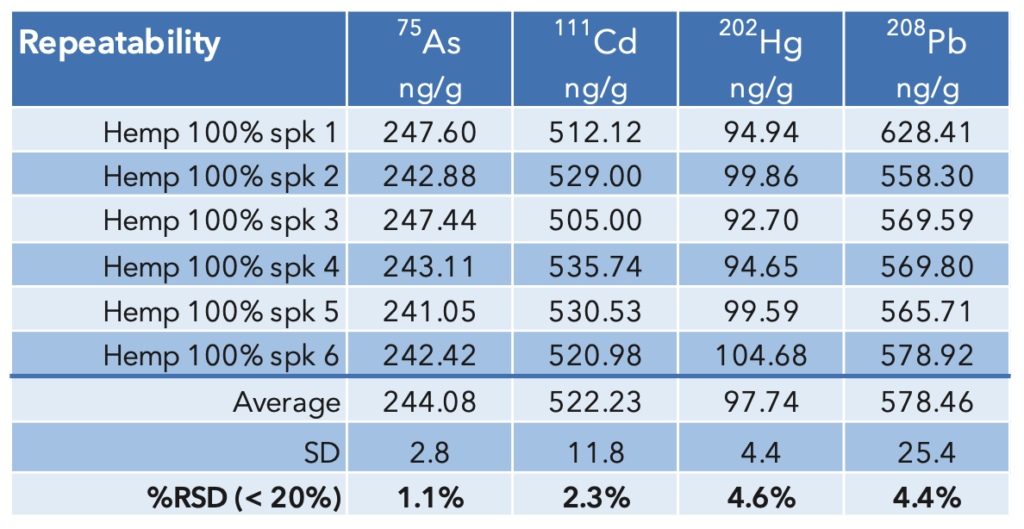
Ruggedness: The repeatability sample set was prepared and run on a different day by a different analyst. The results from that run are combined with the previous run to determine the ruggedness. The ruggedness values are similar to the repeatability values and the measured %RSD (2.4 – 4.0%) are comfortably under the 25% limit defined by the USP method. The results are summarized in Table 8.
Table 8: USP<233> Ruggedness results
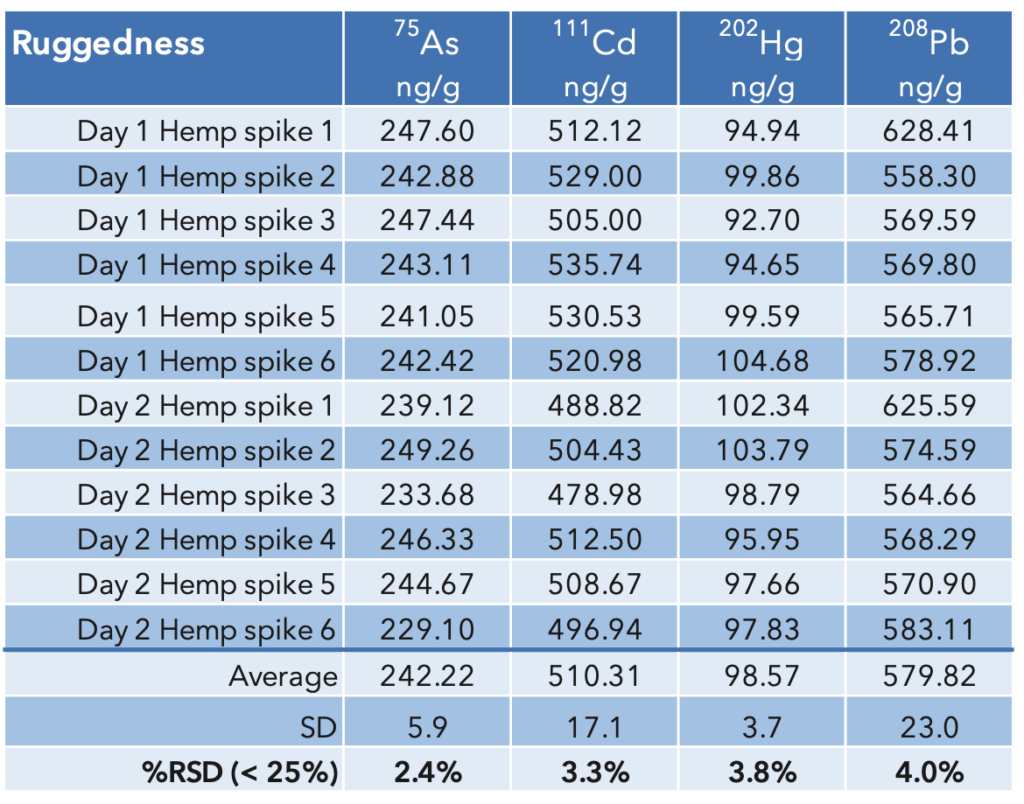
NIST 1575a Results
The results for the NIST SRM are summarized in Table 9. The values for As and Hg were less than
the low standard in solution but there is good agreement between the experimental values and the certified values.
Table 9: NIST 1575a Pine Needles SRM

CONCLUSION
This study demonstrates that the Advion SOLATION® ICP-MS , coupled with a microwave digestion system, is suitable for the accurate, robust and reproducible analysis of heavy metals in hemp plant material – greatly exceeding the requirements of USP <233> protocol.
Validation of the microwave digestion method was reinforced by the excellent recovery results obtained for the NIST SRM 1575 Pine.
Direct Sample Analysis of Fizzy Drinks Without Sample Preparation on a Compact Mass Spectrometer

Mass Spec: expression® CMS
Sampling: ASAP
INTRODUCTION
Chemists are tasked with quickly identifying compounds created, ensuring quality of products, or evaluating safety. Current techniques are adequate, but not all offer the speed, data quality, or ease-of-use provided by the Advion expression® CMS. The CMS with the Advion ASAP offers chemists the ability to rapidly analyze solids, liquids and powders without tedious and time consuming sample preparation.
METHOD
The extended glass capillary of the ASAP was dipped into each fizzy drink sample. The excess was wiped off and the probe was inserted directly into the ASAP-enabled APCI ion source of the CMS, producing results in seconds.
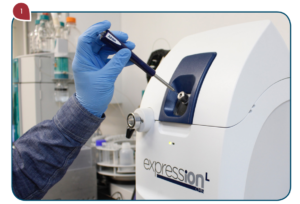
Figure 1: The ASAP containing the sample directly inserted into the ASAP-enabled APCI source of the CMS for analysis.
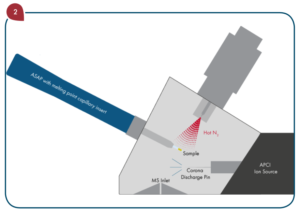
Figure 2: Schematic of the ASAP sampling probe for APCI-CMS analysis.
RESULTS
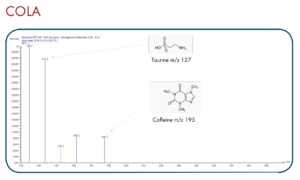
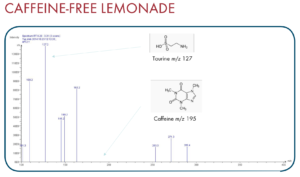
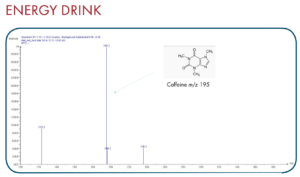
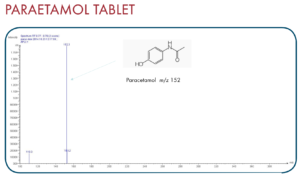
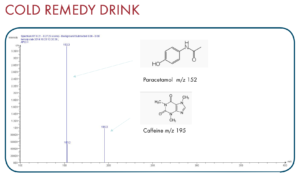
SUMMARY
The ASAP/CMS analysis provided data in < 1 min with no sample preparation and no chromatography, making it ideal for reaction monitoring, compound identification, food safety, and analysis of natural products.
Classifying Cheeses by Volatile APCI (vAPCI) Compact Mass Spectrometry

Mass Spec: expression® CMS
Sampling: vAPCI
INTRODUCTION
Cheese is one of the world’s most popular food types, with a wide variety available for consumers. We commonly eat cheeses from cows, goats, and sheep. The scents and flavors of cheeses, so characteristic to each type of cheese, stem from a complex mixture of chemicals, including free fatty acids. While this mixture is affected by a wide variety of factors we can use the mass spectra to characterize the volatile profiles of different types of cheeses.
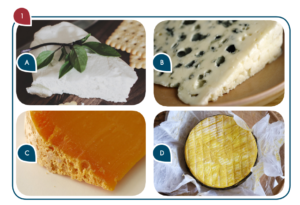
In this application note, we demonstrate the capability of the Advion expression® CMS to analyze volatile fatty acids of various types of cheeses using our volatile APCI (vAPCI) ion source. By heating the cheese samples, we released various volatile compounds, mainly fatty acids, and analyzed the headspace without any sample preparation or derivatization. We then performed statistical analysis to group the cheese samples by their different volatile profiles.
METHODS
Several cheeses of different types were warmed in vessels to 70°C for 2 hours, and the headspaces of the vessels were analyzed using the CMS with a vAPCI ion source, using solvent flow (10 mM4NH4OAc in 1:1 MeOH:H2O) to aid in ionization.
While the cheese samples contained many of the same fatty acids, ions invisible to the naked eye will provide the required information to separate the profiles for each cheese. To look for these differences we performed principle component analysis (PCA) on the mass spectra.
Figure 3: A selection of fatty acids commonly found in different cheese.
RESULTS AND DISCUSSION
The mass spectra show that a wide variety of fatty acids evolve from each of the cheese samples when warmed (Figure 3). Each cheese sample contained many of the same fatty acids (Table 1).
Figure 4: Mass spectra of representative samples of four types of cheese: (A) Goat Cheese, (B) Blue Stilton, (C) Red Leicester, and (D) Wensleydale.
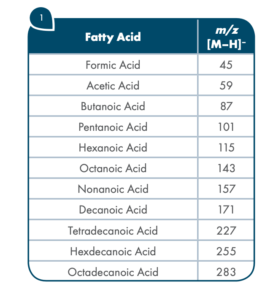
Table 1: Fatty acids observed using vAPCI analysis of cheese samples.
PCA is a statistical tool that is used to look for patterns in data. The resulting plot (Figure 6) shows grouping based on how similar or different samples are from each other. By performing PCA on the data from several samples of each type of cheese, we found that the different cheeses indeed can each be grouped together based on their mass spectra allowing rapid identification using vAPCI analysis. For example, the various goat cheeses had statistically similar spectra and are thus grouped together on the PCA plot. This is generally true of each type of cheese.
Figure 6: PCA of cheese volatile profiles.
The mass spectra of each type of cheese were characteristic; not only were the spectra for cheese samples similar within each type of cheese, but they were substantially different between the different types of cheeses analyzed.
CONCLUSIONS
We used the Advion expression® CMS with a vAPCI ion source to analyze the fatty acids in vapor given off by warmed cheese samples without any additional sample preparation or derivatization. Additionally, we used PCA to show that the spectra of each type of cheese is characteristic to that type of cheese, which allows us to classify the different cheese samples by their type. This would further allow us to identify cheeses by their type using a simple volatile mass spectrometry set up.
Analysis of Volatile Compounds in the Fermentation of Beer

Mass Spec: expression® CMS
Sampling: vAPCI
INTRODUCTION
The chemical analysis of alcoholic beverages is an important step in quality control, being used to monitor flavour profiles across batches, study chemical changes in the product over time, and identify the source of any problems (e.g. off flavours).
The complex flavour of beer is primarily a result of the ingredients used, the brewing method, and conditions during fermentation, and the analysis of beer throughout this process can be invaluable in monitoring fermentation and establishing the point at which problems occur. Being one of the most widely consumed beverages worldwide, rapid and reliable analytical techniques are essential to keep up with demand and production.
Gas or liquid chromatography-mass spectrometry (GC/MS or LC/MS, respectively) are traditionally utilised for quality control in the spirit and beverage industry; however, these techniques can be relatively time-consuming and not necessarily ideal for rapid, high-throughput analysis.
METHOD
Figure 1: Advion expression® CMS with vAPCI heat transfer line.
Figure 2: Schematic of vAPCI/CMS.
Aliquots of the homebrew (1 mL) were collected and analysed 12 hours, 4 days, and 14 days into the fermentation process, in addition to mosaic hop leaves (1 g). The homebrew also contained simcoe and citra hops, which were not analysed.
Each aliquot was sealed in a glass vial and heated to 70oC for 10 minutes. The headspace was drawn directly into the CMS by the Venturi Effect of the vAPCI source for analysis. Samples were analysed in positive ion mode over a range of 30-300 m/z, with a scan time of 400 ms.
RESULTS AND DISCUSSION
Figure 3: Mass spectra of homebrew headspace at (A) 12 hours, (B) 4 days, and (C) 14 days) into fermentation.
There were distinct changes in the overall volatile profile, notably the gradual increase in the m/z 93 ion, likely the protonated ethanol dimer (Figure 3). The concentration of this ion plateaus at the 4 day timepoint, demonstrating fermentation primarily occurred in the first few days.
Figure 4: Mass spectrum of mosaic hops, added 4 days into fermentation.
The headspace of mosaic hops used in in this homebrew were also analysed. The hops mass spectrum (Figure 4) was dominated by ions at m/z 81, 137 and 273, all of which are common ions associated with terpenes, a class of compounds responsible for many of the aromas and flavours of hops. Many of these compounds are of the same molecular weights and thus further analysis would be required to differentiate and identify these components. Components derived from hops are readily detected in the beer aliquots, particularly after the 4 day timepoint, when additional hops were added.
CONCLUSIONS
This study demonstrates the use of the Advion expression® CMS with vAPCI for the analysis of volatile compounds from the headspace of home-brew beer and hops. The Venturi-assisted interface of the instrument enabled rapid sampling of volatiles, allowing the changing volatile profile of the homebrew to be observed throughout the fermentation process. This simple method would be suitable for fast quality control during alcoholic beverage production.
